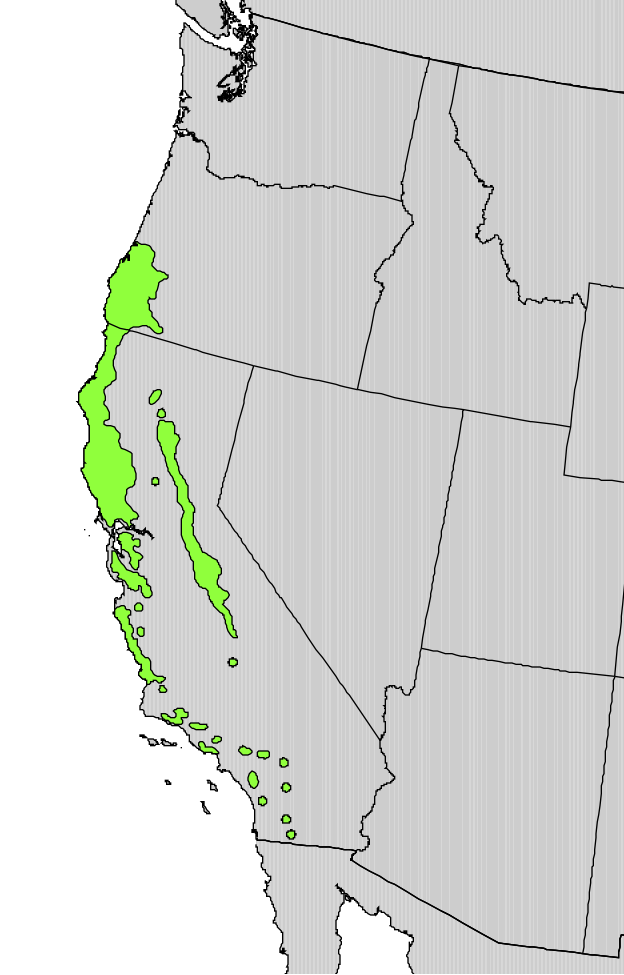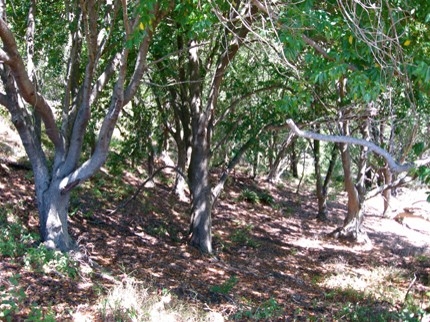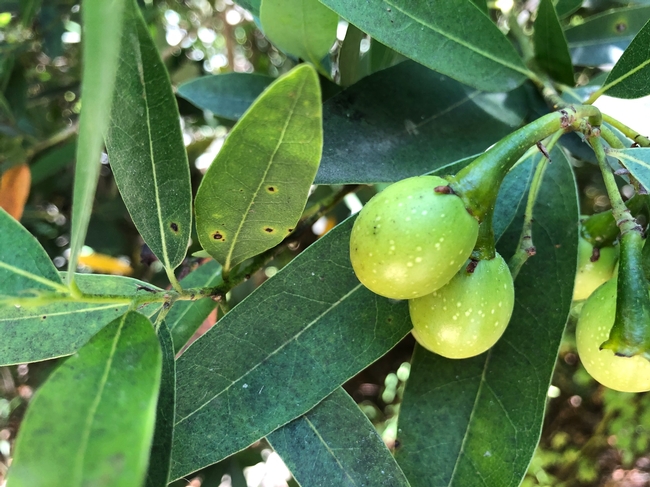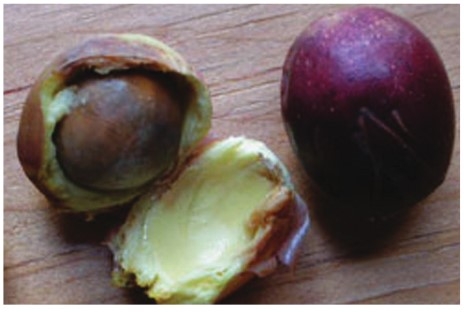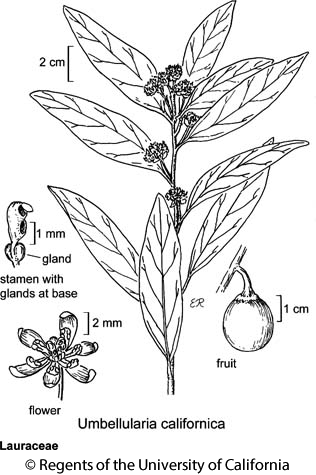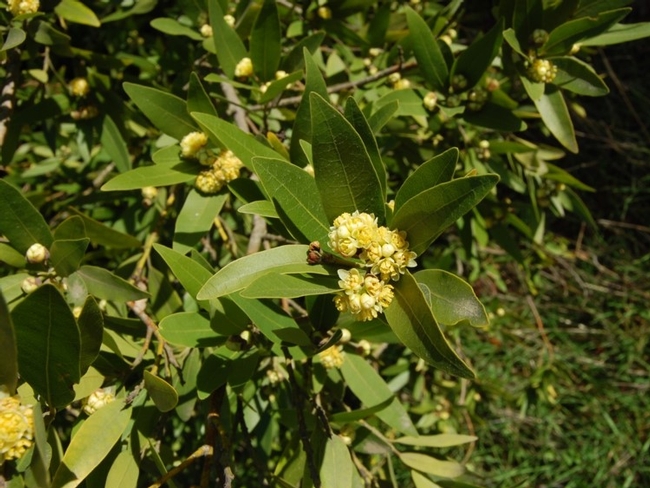The redbay ambrosia beetle, Xyleborus glabratus, and its fungal symbiont, Raffaelea lauricola (Rl), were introduced into Port Wentworth, Georgia, USA, in infested wood packing material from Asia during 2002. This insect-disease complex, commonly called laurel wilt (LW), affects trees in the Lauraceae family and spreads through natural areas by redbay ambrosia beetle movement and anthropogenic movement of infested wood products (e.g., firewood, wood-turners wood, and BBQ smoke-wood). Plant hosts of the redbay ambrosia beetle-Rl complex include at least ten native lauraceous woody species (e.g., redbay [Persea borbonia] and swamp- bay [P. palustris]) in Florida, as well as non-native species such as camphor (Cinnamomum camphora), avocado (P. americana), and potentially California bay (Umbellularia californica). By February 2010, redbay ambrosia beetles were detected in a natural area 21 miles (33.7 km) north of the south Florida avocado production area (125 sq. miles; 324 sq. km) in Miami-Dade County. In 2011, the first confirmed swampbay tree to succumb to LW was documented in this natural area, and by 2012 LW was detected in a commercial avocado grove in Homestead, Florida.
Now everything we know about this disease that affects avocados and other laurel relatives is at one website - articles, videos, webinars, maps. Check it out: https://trec.ifas.ufl.edu/faculty/dr-crane-lw-ab-website/lw-ab/
.png)
.png)
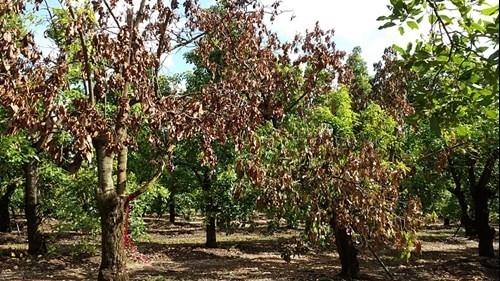
laurel wilt trees
Posted on
Friday, July 23, 2021 at
6:51 AM
Focus Area Tags: Agriculture
Laurel Wilt-Ambrosia Beetle Grower's Seminar to update and discuss testing out-of-the-box control approaches research project. This project was supported by the Florida Avocado Administrative Committee.
Purpose: The Florida Avocado Committee funded a project to investigate the potential for inducing an immune response in avocado trees to infection by the laurel wilt pathogen. The purpose of this seminar is for Dr. Romina Gazis to update the avocado industry on the results of this research. This meeting is open to anyone to attend.
Date: May 27, 2021 (Thursday)
Time: 10AM-11AM (US Eastern Standard Time)
Location: Zoom – see below agenda for link
AGENDA
- Dr. Crane, Welcome and introduction
- Dr. Gazis, “Vaccinating” avocado trees: inoculating avocado trees with selected non-pathogenic fungi and denatured Raffaelea lauricola and their response to the virulent laurel wilt pathogen
- Questions and discussion
Jonathan Crane is inviting you to a scheduled Zoom meeting.
Topic: LW-AB Vaccinating avocado trees
Time: May 27, 2021 10:00 AM Eastern Time (US and Canada) thAt's 7 AM CALIFORNIA TIME
Join Zoom Meeting
https://ufl.zoom.us/j/96300665742
Meeting ID: 963 0066 5742
One tap mobile
+13017158592,,96300665742# US (Washington DC)
+13126266799,,96300665742# US (Chicago)
Dial by your location
+1 301 715 8592 US (Washington DC)
+1 312 626 6799 US (Chicago)
+1 646 558 8656 US (New York)
+1 253 215 8782 US (Tacoma)
+1 346 248 7799 US (Houston)
+1 669 900 6833 US (San Jose)
Meeting ID: 963 0066 5742
Find your local number: https://ufl.zoom.us/u/abptT6RHLD
Join by SIP
96300665742@zoomcrc.com
Join by H.323
162.255.37.11 (US West)
162.255.36.11 (US East)
221.122.88.195 (China)
115.114.131.7 (India Mumbai)
115.114.115.7 (India Hyderabad)
213.19.144.110 (Amsterdam Netherlands)
213.244.140.110 (Germany)
103.122.166.55 (Australia Sydney)
103.122.167.55 (Australia Melbourne)
149.137.40.110 (Singapore)
64.211.144.160 (Brazil)
69.174.57.160 (Canada Toronto)
65.39.152.160 (Canada Vancouver)
207.226.132.110 (Japan Tokyo)
149.137.24.110 (Japan Osaka)
Meeting ID: 963 0066 5742
Join by Skype for Business
https://ufl.zoom.us/skype/96300665742
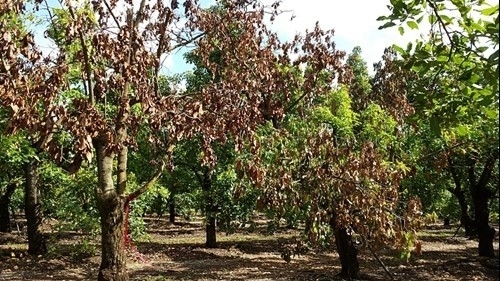
laurel wilt in Florida
Posted on
Wednesday, May 5, 2021 at
8:54 AM
Focus Area Tags: Agriculture
UF/IFAS researchers are working on a decision-support app to help policy makers and growers decide the best regional treatment options for laurel wilt disease, which is challenging Florida's $35 million-a-year avocado crop.
Laurel wilt disease is spread by several ambrosia beetle vectors. People, whether they grow avocados or not, can spread the beetles when they move infested wood products – for example, firewood and wood-turner wood -- UF/IFAS researchers say. UF/IFAS researchers are trying to get all this spreading under control.
To help develop the app, scientists are using the HiPerGator, a supercomputer on the main University of Florida campus in Gainesville, to analyze massive amounts of data.
“This network analysis app will aid policy makers by providing input about how such things as subsidies or penalties for disease management are likely to affect growers' management decisions and resulting disease spread,” said Berea Etherton, a doctoral student in plant pathology in the UF/IFAS College of Agricultural and Life Sciences. “Better regional management as a whole benefits individual growers.”
Scientists hope to gain better regional control of laurel wilt through machine learning for analysis of satellite-images. Those analyses train an artificial intelligence system to recognize patterns from remotely sensed images, said Etherton, who's conducting the research under the supervision of her advisor, UF/IFAS Professor Karen Garrett.
“In the next steps for the project, we plan to integrate satellite image analysis and disease recognition to support decision makers considering the best management strategies,” Garrett said. “The computational demands of the machine-learning tools in this project will benefit from the new HiPerGator resources.”
The UF supercomputer will allow for rapid analysis of large data sets, Etherton said. This project is designed to pass the benefits of the HiPerGator on to the growers, as decision support will include input from satellite images and high-speed processing.
Florida avocados are grown almost entirely in Miami-Dade County. Many consumers love to eat them in a variety of ways, including in guacamole dip. But even as laurel wilt disease damages avocado trees, demand for the fruit continues to rise in global markets. According to UF/IFAS economists, about 80% of Florida's avocados are sold outside Florida and the industry has an economic impact of about $100 million to the state's economy.
Garrett and Etherton are working with researchers at the UF/IFAS Tropical Research and Education Center and the U.S. Department of Agriculture. They all hope the app will help control laurel wilt on a regional basis.
“Any technology that is accessible, efficacious and economical and helps producers combat laurel wilt is welcome,” said Jonathan Crane, UF/IFAS professor of horticulture and a tropical fruit Extension specialist at TREC.
“Managing crop diseases is challenging, because the success of one grower's management strategies often depends on how well other growers are managing the disease. We are working to contribute to regional management strategies,” Garrett said.
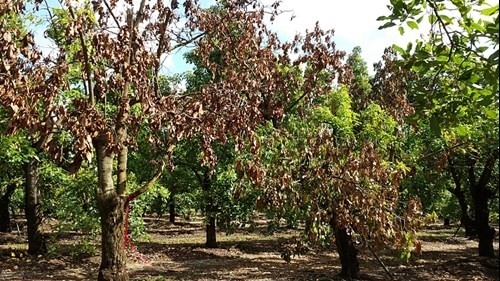
laurel wilt trees
Posted on
Wednesday, November 25, 2020 at
11:08 AM
- Author:
Brad Buck, U of F
Focus Area Tags: Agriculture
California Bay or CA Laurel or Headache Tree or, heaven forbid, Oregon Myrtle is a tree native to the west coast where there is water. In the rainy forests of northern CA and Oregon and the wet creek areas in ravines and canyons of southern CA.
Walking around a barannca the other day along a still wet section of the Ventura River, there was a fruiting bay tree. Fruit that look just like little avocado fruit to which bay is related.
Umbellularia californica is in the Lauraceae along with Persea americana, but sometimes still listed as P. gratissima.
Kingdom:Plantae
Clade:Tracheophytes
Clade:Angiosperms
Clade:Magnoliids
Order:Laurales
Family:Lauraceae
Genus:Umbellularia
Species: U. californica
Bay gets its name from the strong bay laurel odor similar to the culinary laurel – Laurus nobilis –, which is not related to avocado. The odor can be so pungent, that taking strong whiffs of it could bring on a headache, hence the alternative name. The tree can attain a 30 feet height as a single trunked tree or be multi-trunked. The wood is gorgeous hard and is notable in the construction of musical instruments. The seeds were roasted and eaten like acorns. There's been a recent craze to eat dried, ground, powdered avocado seeds which has been discouraged by the CA Avocado Commission.
On the north coast, this tree is subject to Sudden Oak Death – Phytophthora ramorum. It is also subject to avocado root rot, just like avocado. It is also the only California native that is subject to Laurel Wilt Disease which is ravaging the laurel forests of the southeast.
CA Laurel in Flower looks a lot like an avocado flower, hence the reason for being in the same family
Posted on
Friday, August 7, 2020 at
7:15 AM
Focus Area Tags: Agriculture
Laurel Wilt-Ambrosia Beetle Grower's and Advisory Panel meeting to update and discuss research and extension programs supported by the USDA research grant.
Purpose: The Univ. of Florida/IFAS created a panel consisting of local commercial avocado growers and handlers and scientists for the USDA grant on laurel wilt and ambrosia beetles. The purpose of the meeting is for researchers to update avocado growers and the advisory panel on the progress of research on this grant and to discuss future research and extension plans. This meeting is open to anyone to attend.
Date: July 23, 2020
Time: 10AM-12PM
Location: ZOOM, recording available HERE
AGENDA
Dr. Crane, welcome and introduction
Brief updates, plans and discussion:
1. Dr. Schaffer, Environmental Plant Physiology – Laurel wilt susceptibility of avocado scions and rootstocks in relation to physiology and stem anatomy
2. Dr. Gazis, Plant Pathology – Laurel Wilt - Plant Pathology: Research Accomplishments, Current Work, and Future Direction
3. Dr. Carrillo, Entomology – Update laurel wilt ambrosia beetle research
4. Dr. Evans and Mr. Ballen, Ag Economics - current work and work in progress and plans
5. Dr. Crane and Mr. Wasielewski – Current extension program and plans
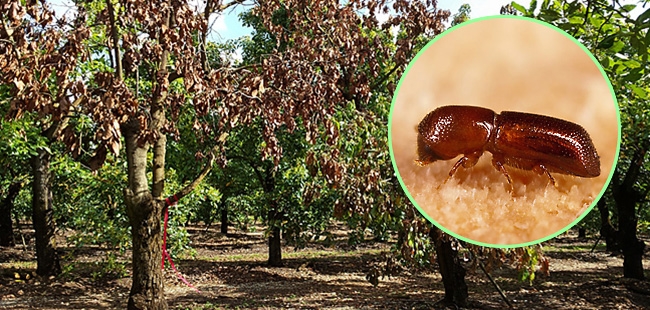
laurel-wilt-and-avocado-trees
Posted on
Monday, July 27, 2020 at
7:17 AM
Focus Area Tags: Agriculture


.png)
.png)



